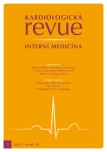Antiphospholipid syndrome – diagnostics, manifestation and treatment
Authors:
H. Ciferská
Authors‘ workplace:
Revmatologický ústav a Revmatologická klinika 1. LF UK, Praha
Published in:
Kardiol Rev Int Med 2014, 16(5): 410-413
Category:
Internal Medicine
Overview
Antiphospholipid syndrome (APS) is an autoimmune disorder characterized by various potentially serious and life‑ threatening manifestations. APS occurs in a primary form with no associated conditions, or in a secondary form associated with various other illnesses (autoimmune, neoplastic and others). APS is diagnosed according to clinical and laboratory criteria. It is characterized by recurrent arterial or venous thrombosis and/ or pregnancy‑related complications and laboratory findings of antiphospholipid antibodies in a minimum time interval of 12 weeks between individual laboratory tests. Clinical manifestations of APS can vary and a multidisciplinary approach is needed. Catastrophic APS is a very serious and life‑ threatening condition associated with high mortality and morbidity, although it is rare. An early diagnosis with proper therapy has a serious impact on the prognosis of patients with APS.
Keywords:
antiphospholipid syndrome – systemic lupus erythematosus
Sources
1. Erkan D, Lockshin MD. What is antiphospholipid syndrome? Curr Rheumatol Rep 2004; 6: 451– 457.
2. Miyakis S, Lockshin MD, Atsumi T et al. International consensus statement on an update of the classification criteria for definite antiphospholipid syndrome (APS). J Thromb Haemost 2006; 4: 295– 306.
3. Kaul M, Erkan D, Sammaritano L et al. Assessment of the 2006 revised antiphospholipid syndrome classification criteria. Ann Rheum Dis 2007; 66: 927– 930.
4. Hughes GR. The antiphospholipid syndrome: ten years on. Lancet 1993; 342: 341– 344.
5. Asherson RA, Khamashta MA, Ordi‑ Ros J et al. The ‘primary’ antiphospholipid syndrome: major clinical and serological features. Medicine (Baltimore) 1989; 68: 366– 374.
6. Giannakopoulos B, Krilis SA. The pathogenesis of the antiphospholipid syndrome. N Engl J Med 2013; 368: 1033– 1044. doi: 10.1056/ NEJMra1112830.
7. Galli M, Luciani D, Bertolini G et al. Anti‑β2– glycoprotein I, antiprothrombin antibodies, and the risk of thrombosis in the antiphospholipid syndrome. Blood 2003; 102: 2717– 2723.
8. Giannakopoulos B, Gao L, Qi M et al. Factor XI is a substrate for xidoreductases: enhanced activation of reduced FXI and its role in antiphospholipid syndrome thrombosis. J Autoimmun 2012; 39: 121– 129. doi: 10.1016/ j.jaut.2012.05.005.
9. Sugi T, Matsubayashi H, Inomo A et al. Antiphosphatidylethanolamine antibodies in recurrent early pregnancy loss and mid‑ to‑ late pregnancy loss. J Obstet Gynaecol Res 2004; 30: 326– 332
10. The American College of Obstetricians and Gynecologists. Antiphospholipid Syndrome. ACOG Practice Bulletin No. 18 2011; 117: 192– 199. doi: 10.1097/ AOG.0b013e31820a61f9.
11. Cervera R, Piette JC, Font J et al. Euro‑Phospholipid Project Group. Antiphospholipid syndrome: clinical and immunologic manifestations and patterns of disease expression in a cohort of 1,000 patients. Arthritis Rheum 2002; 46: 1019– 1027.
12. Asherson RA, Cervera R, de Groot PG et al. Catastrophic antiphospholipid syndrome: international consensus statement on classification criteria and treatment guidelines. Lupus 2003; 12: 530– 534.
13. de Laat B, Wu XX, van Lummel M et al. Correlation between antiphospholipid antibodies that recognize domain I of β2- glycoprotein I and a reduction in the anticoagulant activity of annexin A5. Blood 2007; 109: 1490– 1494.
14. Keeling D, Mackie I, Moore GW et al. British Committee for Standards in Hematology. Guidelines on the investigation and management of antiphospholipid syndrome. Br J Haematol 2012; 157: 47– 58. doi: 10.1111/ j.1365‑ 2141.2012.09037.x.
15. Ruiz‑ Irastorza G, Cuadrado MJ, Ruiz‑ Arruza I et al.Evidence‑based recommendations for the prevention and long‑term management of thrombosis in antiphospholipid antibody‑ positive patients: report of a task force at the 13th International Congress on antiphospholipid antibodies. Lupus 2011; 20: 206– 218. doi: 10.1177/ 096120
Labels
Paediatric cardiology Internal medicine Cardiac surgery CardiologyArticle was published in
Cardiology Review

2014 Issue 5
Most read in this issue
- Treatment of anemia and iron deficiency from the hematologist’s perspective
- Antiphospholipid syndrome – diagnostics, manifestation and treatment
- Adverse effects of biological therapy in rheumatology
- Systemic sclerosis
